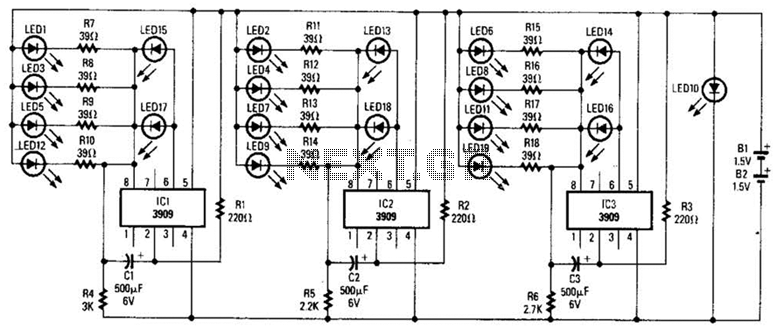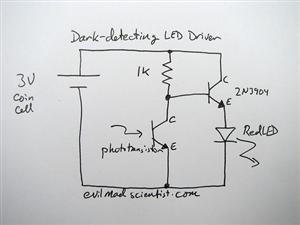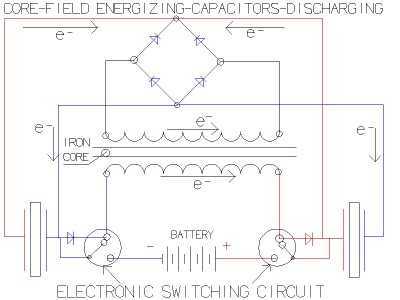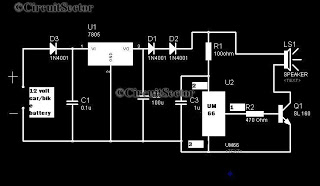
Led Christmas Tree Light Flasher Circuit

Three individual flashing circuits utilizing an LM3909 LED flasher/oscillator IC create the illusion of a pseudo-random firing order. The capacitors CX1, CX2, and CX3 control the blink rate, which ranges from 0.3 to 0.8 seconds. The wide tolerance range of standard electrolytic capacitors, from -20% to +80%, contributes to the irregularities in the blink cycles. The continuous current drain is approximately 10 mA; however, decreasing the values of resistors R4 through R6 or capacitors C1 through C3 to increase the blink rate will also result in a proportional increase in current. Notably, external current-limiting resistors are not required for LEDs 13 through 18, as these resistors are integrated within the ICs. LED 10, which functions as the tree's star, is a specialized flashing LED that blinks continuously at a fixed rate.
The circuit design features three independent flashing circuits, each employing the LM3909 integrated circuit. This IC is known for its ability to generate a flashing effect in LEDs, and in this application, it is configured to create a visually appealing pseudo-random firing sequence. The blink rate is adjustable through three capacitors (CX1, CX2, CX3), which determine the timing intervals for the flashing LEDs. The selected values for these capacitors directly influence the frequency of the output, with a specified range between 0.3 and 0.8 seconds per flash. The variability in this timing is further enhanced by the inherent tolerance of the electrolytic capacitors used in the circuit, which can vary significantly, thereby introducing a degree of randomness to the flashing pattern.
The circuit consumes a continuous current of approximately 10 mA under normal operating conditions. However, it is important to note that if the values of resistors R4, R5, and R6 or capacitors C1, C2, and C3 are reduced to achieve a faster blink rate, the current draw will increase proportionally. This relationship between component values and current consumption must be carefully managed to ensure that the circuit operates within safe limits without overheating.
In terms of LED configuration, the design includes LEDs 13 through 18, which do not require external current-limiting resistors due to the built-in resistors within the LM3909 IC. This feature simplifies the circuit design and reduces the number of required components. LED 10, designated as the star of the display, is a unique flashing LED that operates at a fixed rate, providing a consistent point of light amidst the varying patterns of the other LEDs. This combination of features allows for a dynamic and visually captivating lighting effect suitable for decorative applications. Three individual flashing circuits that use an LM3909 LED flasher/oscillator IC create the appearance of a pseudo-random firing order. The combination of CX!RV C.JRb, and C^R control the blink rate, which is between 0.3 and 0.8 s, and the inherent wide tolerance range [-20% to +80%) of standard electrolytic capacitors add to the irregularities of the blink cycles.
The continuous current drain is about 10 mA; however, if you decrease the values of R4 through R6 or CI through C3 in order to increase the blink rate, the current will then increase proportionally. Note in particular that external current-limiting resistors aren`t needed for LED 13 through LED18; the resistors are built into the ICs. LED10, which serves as the tree`s star, is a special kind of flashing LED that blinks continuously at a fixed rate.
The circuit design features three independent flashing circuits, each employing the LM3909 integrated circuit. This IC is known for its ability to generate a flashing effect in LEDs, and in this application, it is configured to create a visually appealing pseudo-random firing sequence. The blink rate is adjustable through three capacitors (CX1, CX2, CX3), which determine the timing intervals for the flashing LEDs. The selected values for these capacitors directly influence the frequency of the output, with a specified range between 0.3 and 0.8 seconds per flash. The variability in this timing is further enhanced by the inherent tolerance of the electrolytic capacitors used in the circuit, which can vary significantly, thereby introducing a degree of randomness to the flashing pattern.
The circuit consumes a continuous current of approximately 10 mA under normal operating conditions. However, it is important to note that if the values of resistors R4, R5, and R6 or capacitors C1, C2, and C3 are reduced to achieve a faster blink rate, the current draw will increase proportionally. This relationship between component values and current consumption must be carefully managed to ensure that the circuit operates within safe limits without overheating.
In terms of LED configuration, the design includes LEDs 13 through 18, which do not require external current-limiting resistors due to the built-in resistors within the LM3909 IC. This feature simplifies the circuit design and reduces the number of required components. LED 10, designated as the star of the display, is a unique flashing LED that operates at a fixed rate, providing a consistent point of light amidst the varying patterns of the other LEDs. This combination of features allows for a dynamic and visually captivating lighting effect suitable for decorative applications. Three individual flashing circuits that use an LM3909 LED flasher/oscillator IC create the appearance of a pseudo-random firing order. The combination of CX!RV C.JRb, and C^R control the blink rate, which is between 0.3 and 0.8 s, and the inherent wide tolerance range [-20% to +80%) of standard electrolytic capacitors add to the irregularities of the blink cycles.
The continuous current drain is about 10 mA; however, if you decrease the values of R4 through R6 or CI through C3 in order to increase the blink rate, the current will then increase proportionally. Note in particular that external current-limiting resistors aren`t needed for LED 13 through LED18; the resistors are built into the ICs. LED10, which serves as the tree`s star, is a special kind of flashing LED that blinks continuously at a fixed rate.





